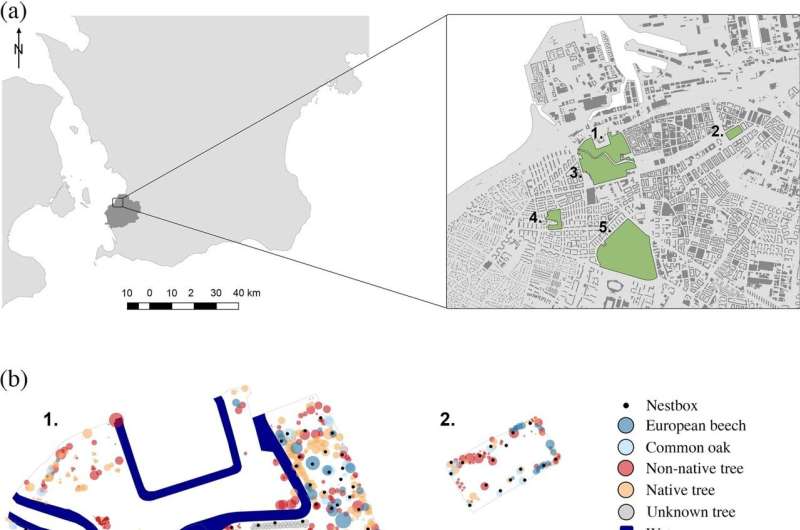This article has been reviewed according to Science X's editorial process and policies. Editors have highlighted the following attributes while ensuring the content's credibility:
fact-checked
peer-reviewed publication
trusted source
proofread
Urban birds prefer native trees, shows long-term study

Small passerine birds, such as blue and great tits, avoid breeding in urban areas where there are many non-native trees. Chicks also weigh less the more non-native trees there are in the vicinity of the nest. This is shown in a long-term study from Lund University in Sweden.
City trees contribute to several important ecosystem services such as lowering local temperature and purifying air but are also homes to birds and insects. Vegetation, especially trees, is the primary managed biological component of a city's ecosystem. It is therefore important to understand the consequences of our planning of parks and green spaces. To find out how different types of trees affect birdlife, a research team, led by Lund University, monitored 400 nest boxes in five parks in the Swedish city Malmö over a seven-year period.
The results, now published in the journal, Oecologia, show that native trees—defined in the study as species that have been in the ecosystem for at least 700 years—provide more resources and are preferred by urban birds.
"Non-native trees, also known as introduced, exotic or alien species, lack an evolutionary history with the local ecosystem. We have previously shown that non-native tree species have substantially fewer insects than native trees, so the effect we are now seeing is probably a result of a shortage of food for insectivorous birds, such as the great tit," says Johan Kjellberg Jensen, doctoral student in Urban Ecology at Lund University.
Introduced tree species are common in urban planning globally. In the city parks of Malmö, about one in four trees are non-native. These non-native trees are, in fact, being advocated by some for being more tolerant to the harsh conditions of cities. However, it is important to understand the consequences of their presence for the local ecosystem.
"If you want to hear more birdsong in spring, I think the choice of urban trees is an important factor. If you increase the number of native trees in city parks and green spaces, our local birds are more likely to thrive," says Johan Kjellberg Jensen.
Related research on the effects of tree origin in North America has shown, similarly, that locally-native plants in gardens are more beneficial for insect and bird populations. Results that now have been confirmed, and expanded to the urban environment, in the new Lund University study. Long-term studies like this are more reliable, according to Johan Kjellberg Jensen, who sees no reason for results to be substantially different between cities, at least not in countries with a similar climate to Sweden.
"I hope that city planners and other stakeholders take note of this research and that we together can develop strategies to ensure a functioning ecosystem in our cities," he says.
More information: Johan Kjellberg Jensen et al, Urban tree composition is associated with breeding success of a passerine bird, but effects vary within and between years, Oecologia (2023). DOI: 10.1007/s00442-023-05319-8
Journal information: Oecologia
Provided by Lund University





















